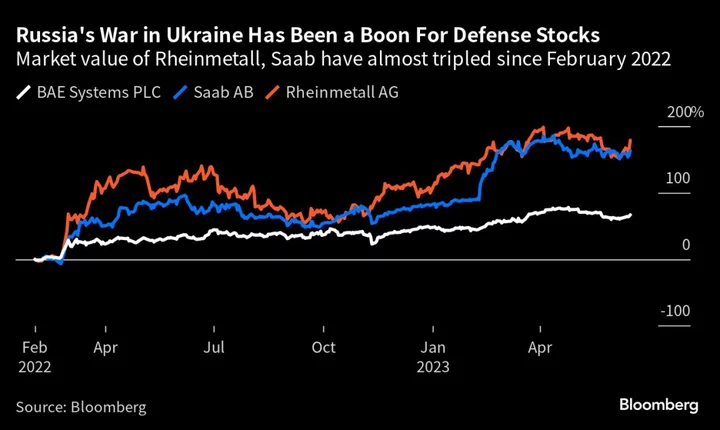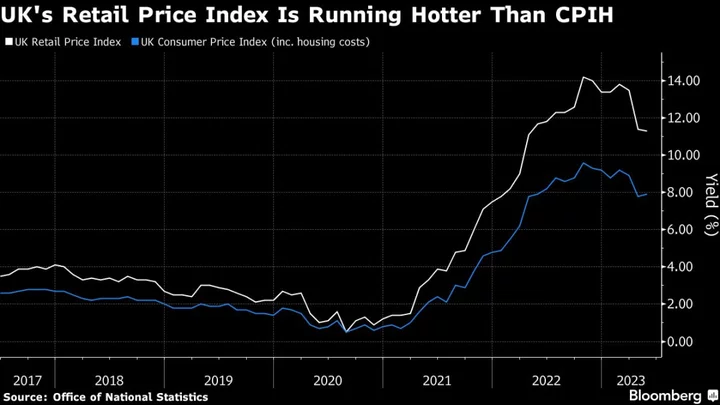“Before, we had time, but no money,” said Tommy Gustafsson-Rask, head of BAE Systems Hägglunds AB, reflecting a common theme across Europe’s defense industry. “Today, we have money, but no time.”
Almost 18 months into the war in Ukraine, Europe’s defense contractors — flooded with demand for everything from ammunition to shoulder-launched missiles and combat vehicles — face a dilemma. Do they gamble on expanding production, assuming that the war and tensions with Russia will last indefinitely? Or hold back until they get long-term commitments from governments that have spent the past few decades shaving or even slashing their defense budgets?
The calculation matters beyond the corporate offices of Europe’s defense industry, which collectively generates about €120 billion a year in revenues. Ukraine urgently needs more weapons, from artillery ammunition to air defense systems, and allies’ stocks are running low. European capitals are trying to revive their own sleepy industries to both sustain weapons deliveries to Kyiv and bolster their own security. Additionally the North Atlantic Treaty Organization wants to boost the size of its so-called high-readiness forces — a pool made up of allies' troops ready to deploy in less than 30 days — to 300,000, a seven-fold increase, all of whom will need high quality weapons ready for use.
European defense ministries have long-standing business ties with US weapons makers like Raytheon Technologies Corp. or Lockheed Martin Corp, but America’s powerful industry alone cannot fulfill all global demand. The US is struggling with low stock levels of artillery ammunition, leading Washington to take the controversial decision to send Ukraine cluster munitions, despite concerns that the weapons pose a grave danger to civilians. With US President Joe Biden urging Europe to shoulder more responsibility for its own defense, large countries like Germany, France, and Italy want to reduce their dependence on US military supply chains and help build their own national champions.
NATO leaders are expected to back a European defense industry blueprint that calls for multinational joint procurement when they meet in Vilnius, the Lithuanian capital, for their annual summit on Tuesday. The plan also urges countries to adopt streamlined standards to ensure the same ammunition works with different countries’ weapons systems.
The tension between European defense ministries and companies revolves around who should take the lead. Even as orders start to pile in, the fear in the industry is that it could expand production only to find that when new facilities open in three or five years’ time, there is no demand. Governments have backtracked on plans before and many European capitals have repeatedly failed to meet NATO targets on stockpiling or the pledge to spend at least 2% of gross domestic product on defense. NATO allies on Friday agreed a firmer commitment to hit the 2% target.
It is not a misplaced fear. Some governments are hesitating to place long-term contracts for weapons because they are unsure whether they will need them in the future, a European diplomat said.
Read more: Solidarity or Squabbling: Five Things to Watch at NATO’s Summit
The industry — which faces shortages of skilled labor and key components — has gone as far as it can to optimize or expand production with its own investment, said Andrea Nativi, chairman of business association ASD Europe’s defense unit. Now, the sector needs transparency about where government demand will go over the coming years, he said.
“We want to see the words followed by action — real action,” said Nativi. He added that on top of long-term contracts, governments could also take other measures including directly helping pay for expanded production or give priority access to energy.
While some governments accept they could do more to help the industry, there is also a view from officials that defense companies need to shoulder more of the burden, especially to speed up delivery times. At BAE Systems, increased demand and supply chain bottlenecks, triggered by semiconductor shortages and other logistical issues earlier this year, meant delivery times for some of its combat or armored vehicles peaked at seven years — more than three times longer than before the war. That means a vehicle ordered today would not arrive until 2030.
“From the business point of view, they are trying to mitigate the risks to survive” once demand falls, Greta Monika Tučkutė, Lithuania’s vice-minister of defense, said of the defense companies. “But I think business needs to also take the risk.”
“They are earning now, and benefiting a lot at this moment,” added Tučkutė, “so they need equally to take the risk investing into development of their industry.”
The War Business Model
When Gustafsson-Rask initially took over at BAE Systems’ Sweden-based combat vehicle subsidiary Hägglunds in 2011 he had to fire a quarter of its staff. Today, the company is scouring the region for new skilled labor as it bids to double its headcount to close to 1,700 by the end of the year and expand its operations. It forecasts that annual revenues will rise four-fold over the next five years to $1.2 billion.
This increased demand will take time to work through to companies’ balance sheets as firms get paid once orders are filled, but defense stocks are booming. Germany’s Rheinmetall AG — manufacturer of Leopard 2 battle tanks and artillery ammunition— surged 130% in 2022, making it the best-performing stock in Europe, while other European defense companies such as Thales SA, Dassault Aviation SA and Saab AB gained between 60% and 80%. The gains are continuing into 2023, with double digit percentage growth for the companies year-to-date.
It marks a major turnaround for the European defense sector, which has faced years of curtailed spending since the collapse of the Soviet Union. In 1988, European countries spent a total of $343 billion on their militaries, according to the Stockholm International Peace Research Institute, which bases the figures on 2021 prices and exchange rates. By 2013, that figure had shrunk by a fifth to $275 billion. Russia's annexation of Crimea in 2014 reversed that trend, with spending increasing every year since. It hit $357 billion in 2022 with European countries spending large amounts of their defense budgets on American kit, especially modern F-35 fighter jets.
Germany may be the starkest example of chronic defense underspending in Europe. As recently as 2018, shortages of field equipment, vehicles, and aircraft were so commonplace that the German parliament's armed forces commissioner declared the military unfit to defend Germany and its NATO allies.
Europe wants to re-power the region as a hub for defense industrial production. But the sector faces numerous hurdles. Along with limited supplies of skilled labor, contractors also face shortages of components and bureaucratic hurdles to secure permits. Some banks are reluctant to lend to the sector out of concern it could tarnish their ESG credentials, industry representatives, investors and NATO officials say.
Government bureaucracies need to restaff to vet and place orders and with complex items in particular, officials can’t rush the process as they need to do a variety of assessments. In Germany, for instance, the defense ministry needs parliamentary approval for any order above €25 million, which would buy roughly 7,500 155mm artillery shells, according to calculations based on a Rheinmetall press release from 2022. That amount would last Ukraine less than a day given the rate of shelling by both sides in the conflict.
At Renk AG, which makes transmissions for tanks, including the Leopard 2 used by many NATO militaries, executives could soon face a labor crunch if orders pick up, given they are already struggling to fill at least 100 jobs. “There’s competition for these workers,” said the company’s Chief Executive Officer Susanne Wiegand on the assembly floor of its factory in Augsburg, Germany. “You have to offer good, attractive jobs — that’s only partly related to pay.”
The European Union last week agreed to a raft of measures aimed at boosting the bloc’s production of ammunition and missiles, including €500 million to help companies ramp-up manufacturing capacities.
The reality, say many in the industry, is that even with more orders coming in and companies already expanding facilities, production in Europe will take years to match demand after the post-Cold War spending pull-back atrophied manufacturing and supply chain networks.
Görgen Johansson, head of Saab’s Dynamics business area, said his business unit scaled up production last year and plans to double it, but the expansion will take two to three years. Only then will the company be able to return to pre-war delivery times. Expansion requires building factories, ordering machines and locking in supply chains, he said.
“We have already increased as much as possible right now,” added Johansson, at the company’s Karlskoga production facility. “It will take a couple of years to have full production at the levels the customers are looking for.”
Delays as European firms struggle to ramp up may tempt governments to look elsewhere — to the US, Israel or South Korea – to procure weapons more quickly. Poland is spending up to $15 billion on American Patriot missile defense equipment, while a German-led coalition of allies is planning to buy Patriot and Israeli Arrow 3 air defense systems to create a European anti-missile shield to counter the threat from Russia. Poland has also become South Korea's biggest arms customer since the war started, including a $5.76 billion agreement for K2 tanks and self-propelled K9 howitzers, weapons similar to those made by European competitors.
That may perpetuate the production problem in Europe, according to Lucie Béraud-Sudreau, who tracks arms production at SIPRI.
“If you're in a hurry and you want to replenish relatively quickly that might make sense,” she said. “But in the long run you're creating a vicious cycle where you're not giving the market to European companies, which makes it more difficult to scale up."
Gunpowder Plot
On an average day Ukraine and Russia fire tens of thousands of artillery shells at each other — a rate faster than allies can manufacture them. At one stage this year Russia was firing a similar amount of ammunition at Ukraine in a single day as Europe was able to produce in a month. It has taught many countries an important lesson: they have drastically miscalculated the levels of standing ammunition stocks they need to be properly prepared for a conflict.
NATO defense ministers in June agreed to significantly raise the recommended levels of ammunition critical to battle held by each member state, including 155mm artillery shells. While the targets are secret, Germany alone aims to increase its stock more than 10-fold from about 20,000 shells today to 230,000 by 2031, according to a German defense ministry document seen by Bloomberg.
“European stocks are not sufficient, and we should manufacture faster and more,” said Estonia’s Prime Minister Kaja Kallas, who recently estimated that long-term it would cost Europe several trillion euros to replenish to the required levels stocks of all categories of munitions. “This is necessary to support Ukraine sufficiently, but more importantly, it is necessary for lifting our own defense to match the new security reality.”
“Defense is not escalation,” Kallas added. “We need to build deterrence that stops Russia’s cycle of aggression against its neighbors.”
NATO officials hope the new guidelines on stock levels will act as a clear commitment of help for defense manufacturers and a reassurance that they should boost production as quickly as possible. Russia’s invasion has radically revised expectations about what a future war could look like. Instead of prioritizing drones and fighter jets, countries now also need to be armed with air defense systems, artillery and vast amounts of ammunition in light of the First and Second World War-style of fighting seen in Ukraine.
The European Union is trying to focus efforts around the most critical need for Ukraine and its allies — artillery ammunition. Its plan includes an agreed €2 billion reimbursement to countries that have already contributed their own stocks to Kyiv and combined orders to European defense companies. The aim is to send Ukraine at least 1 million rounds of artillery ammunition within a year, starting from early February 2023 and would come on top of anything governments buy for their own militaries.
The goal is ambitious. Europe’s defense industry annually produces around 300,000 155mm shells, the most sought-after caliber for NATO-grade artillery guns, according to a paper drafted earlier this year by Estonia’s defense ministry and seen by Bloomberg. The EU doesn’t provide figures on the industry’s production capacity.
For companies like Rheinmetall, one of the biggest manufacturers of 155mm artillery and 120 mm tank ammunition, the target is further complicated by concerns around supplies of propellant powder and explosives, crucial materials for the production of shells and artillery components. While they are not facing shortages under current production, that could change with larger orders, potentially hampering the company’s ability to meet demand.
Read more: Populist Puppet or Biden Ally? Who is Poland’s Andrzej Duda
The capacity to produce propellant powder in Europe is limited. Rheinmetall is the biggest producer in the region, but it only has two production sites: one in Bavaria and another in Switzerland and those sites are operating at full capacity seven days a week.
In addition to expanding explosives capacity at a site in Hungary, the company is in talks with the local government in Saxony in eastern Germany to build a new propellant powder factory. Rheinmetall has demanded government subsidies for it to go ahead with the plan, which has stalled negotiations. The case is likely to be closely watched by other manufacturers looking for any hint of state support. Even when construction begins, the plant would take at least 18 months to come online.
“If the capacity for explosives and for propellant powder in Europe is not expanded soon, it will be very difficult to meet the rapidly increasing demand for artillery ammunition in Europe and Ukraine,” said Oliver Hoffmann, a spokesman for Rheinmetall.
In the short-term, that may mean allies might be less willing to part with their existing stocks of shells to send to Ukraine. But without more ammunition, Kyiv may fail to significantly break through Russian lines and push ahead with their counter-offensive.
Back at Saab's land warfare business, Johansson's unit has seen increased demand for his company's grenade launchers — the AT4 and Carl-Gustaf systems – as well as its anti-tank NLAW weapons.
Those weapons, which allies have sent to Kyiv, have been credited with helping Ukrainian forces take out heavy Russian tanks. Now allies are looking to rapidly replenish their own stocks so when they ask if Saab has anything in storage, they are inevitably disappointed.
"What we see from the countries right now is that they would like to have very quickly a war production built up” but it takes a couple of years, said Johansson. “In a situation like this, every customer wants the products now or very quickly.”
--With assistance from Natalia Ojewska and Alberto Nardelli.
Author: Natalia Drozdiak, Jonas Ekblom and Alexander Michael Pearson









